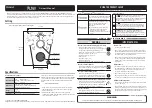
Beam Width Measurement Criteria
5.4.2
All laser beam parameter measurements are computed based on beam width measurements. Therefore,
accurate beam width measurements are essential to a high quality laser propagation measurement system.
Additionally, the basis chosen for making the beam width measurement must conform to beam propagation
theory.
The beam width measurement method that conforms to beam propagation theory is referred to as the second
moment method. One such method is D4σ, which defines the beam widths as 4 times the standard deviation
(σ), evaluated in the transverse X and Y directions over the beam intensity profile. Making this 4σ
measurement directly with great precision can be difficult. BeamSquared employs special algorithms that allow
it to perform very accurate second moment measurements. Some of these methods are covered under U.S.
Patent No. 5,418,562. The latest ISO 11146 procedures describes this patented approach.
Under certain conditions, results using direct second moment measurements may be less than satisfactory.
BeamSquared has included alternate beam width measurement techniques to compensate for this. These
methods degrade accuracy but may provide more correct results when extraneous noise is present in the
beam wings. The ISO procedure recognizes the problems with making direct second moment beam width
measurements and allows for alternate measurement methods.
The knife edge method is described in the ISO procedure and has been adapted to BeamSquared.
A programmable
Encircled Power Smallest Aperture
(
EPSA
) beam width method is also included,
commonly referred to as Power in a Bucket. A non-visible circular aperture is centered on the beam centroid,
and the diameter is adjusted until it contains a percentage of the beam energy. This percentage is entered by
the user. Because the aperture is always circular, the X and Y results always reports the same values when
using this method. 86.5% is the default value and represents the second moment setting for a TEM
00
Gaussian
beam.
Whichever method is employed, users should stay with one approach in order to maintain a good basis for
comparison between similar lasers or setup conditions.
See section 6.1.2.2 for more details about the beam width measurement methods.
Содержание BeamSquared
Страница 10: ......
Страница 15: ...BeamSquared Optical Train Dimensions 1 4 ...
Страница 75: ...400mm Focal Length Lens M2 1 500mm Focal Length Lens M2 1 ...
Страница 87: ......
















































